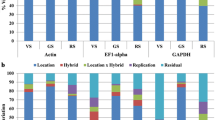Abstract
Transgenic plants in the US and abroad generated using genetic engineering technology are regulated with respect to release into the environment and inclusion into diets of humans and animals. For crops incorporating pharmaceuticals or industrial enzymes regulations are even more stringent. Notifications are not allowed for movement and release, therefore a permit is required. However, growing under permit is cumbersome and more expensive than open, non- regulated growth. Thus, when the genetically engineered pharmaceutical or industrial crop is ready for scale-up, achieving non-regulated status is critical. Regulatory compliance in the US comprises petitioning the appropriate agencies for permission for environmental release and feeding trials. For release without yearly permits, a petition for allowing non-regulated status can be filed with the United States Department of Agriculture with consultations that include the Food and Drug Administration and possibly the Environmental Protection Agency, the latter if the plant includes an incorporated pesticide. The data package should ensure that the plants are substantially equivalent in every parameter except for the engineered trait. We undertook a preliminary study on transgenic maize field-grown hybrids that express one of two cellulase genes, an exo-cellulase or an endo-cellulase. We performed field observations of whole plants and numerous in vitro analyses of grain. Although some minor differences were observed when comparing genetically engineered hybrid plants to control wild type hybrids, no significant differences were seen.






Similar content being viewed by others
References
Baker J, Ehrman C, Adney W, Thomas S, Himmel M (1998) Hydrolysis of cellulose using ternary mixtures of purified celluloses. Appl Biochem Biotechnol 70–72:395–403
Bradford KJ, Van Deynze A, Gutterson N, Parrott W, Strauss SH (2005) Regulating transgenic crops sensibly: lessons from plant breeding, biotechnology and genomics. Nat Biotechnol 23:439–444
Castle LA, Wu G, McElroy D (2006) Agricultural input traits: past, present and future. Curr Opin Biotechnol 17:105–112
Church GM, Gilbert W (1984) Genomic sequencing. Proc Natl Acad Sci 81:1991–1995
Fischer R, Stoger E, Schillberg S, Christou P, Twyman RM (2004) Plant-based production of biopharmaceuticals. Curr Opin Plant Biol 7:152–158
Fraley RT (2009) Molecular genetic approaches to maize improvement–an introduction. In: Kriz AL, Larkins BA (eds) Molecular genetic approaches to maize improvement, vol 63. Springer, Berlin Heidelberg, pp 3–6
Hayden C, Fake G, Carroll J, Hood E, Howard J (2012) Synergistic activity of plant extracts with microbial cellulases for the release of free sugars. Bioenergy Res 5:398–406
Herman RA, Price WD (2013) Unintended compositional changes in genetically modified (gm) Crops: 20 years of research. J Agric Food Chem 61(48):11695–11701
Hood EE, Howard JA (2009) Over-expression of novel proteins in maize. In: Kriz AL, Larkins BA (eds) Molecular genetic approaches to maize improvement. Springer, Berlin Heidelberg, pp 91–105
Hood E, Witcher D, Maddock S, Meyer T, Baszczynski C et al (1997) Commercial production of avidin from transgenic maize: characterization of transformant, production, processing, extracting, and purification. Mol Breed 3:291–306
Hood EE, Bailey MR, Beifuss K, Magallanes-Lundback M, Horn ME, Callaway E, Drees C, Delaney DE, Clough R, Howard JA (2003) Criteria for high-level expression of a fungal laccase gene in transgenic maize. Plant Biotechnol J 1:129–140
Hood EE, Love R, Lane J, Bray J, Clough R, Pappu K, Drees C, Hood KR, Yoon S, Ahmad A, Howard JA (2007) Subcellular targeting is a key condition for high-level accumulation of cellulase protein in transgenic maize seed. Plant Biotechnol J 5:709–719
Hood EE, Devaiah SP, Fake G, Egelkrout E, Teoh K, Requesens DV, Hayden C, Hood KR, Pappu KM, Carroll J, Howard JA (2012) Manipulating corn germplasm to increase recombinant protein accumulation. Plant Biotechnol J 10:20–30
Howard JA, Donnelly KC (2004) A quantitative safety assessment model for transgenic protein products produced in agricultural crops. J Agric Environ Ethics 17:545–558
Howard JA, Hood E (2005) Bioindustrial and biopharmaceutical products produced in plants. Adv Agron 85:91–124
Miller JK, Bradford K (2010) The regulatory bottleneck for biotech specialty crops. Nat Biotechnol 28:1012–1014
Pollack A (2011) US approves corn modified for ethanol. The New York Times (February 11, B1)
Ratner M (2010) Pfizer stakes a claim in plant cell-made biopharmaceuticals. Nat Biotechnol 28:107–108
Southern EM (1975) Detection of specific sequences among DNA fragments separated by gel electrophoresis. J Mol Biol 98:503–517
Sparrow P, Broer I, Hood EE, Eversole K, Hartung F, Schiemann J (2013) Risk assessment and regulation of molecular farming-a comparison between Europe and US. Curr Pharm Des 19(31):5513–5530
Woodard S, Mayor J, Bailey M, Barker D, Love R, Lane J, Delaney D, McComas-Wagner J, Mallubhotla H, Hood E (2003) Maize (Zea mays)-derived bovine trypsin: characterization of the first large-scale, commercial protein product from transgenic plants. Biotechnol Appl Biochem 38:123–130
Acknowledgments
The authors acknowledge the National Science Foundation EPSCoR state wide grant to Arkansas, ASSET I (EPS-0701890) and USDA SBIR (2009-33610-19721) for partial funding of this work. We also thank Infinite Enzymes, LLC (Jonesboro, AR) for providing the seed for planting.
Author information
Authors and Affiliations
Corresponding author
Electronic supplementary material
Below is the link to the electronic supplementary material.
Rights and permissions
About this article
Cite this article
Garda, M., Devaiah, S.P., Vicuna Requesens, D. et al. Assessment of field-grown cellulase-expressing corn. Transgenic Res 24, 185–198 (2015). https://doi.org/10.1007/s11248-014-9838-4
Received:
Accepted:
Published:
Issue Date:
DOI: https://doi.org/10.1007/s11248-014-9838-4




